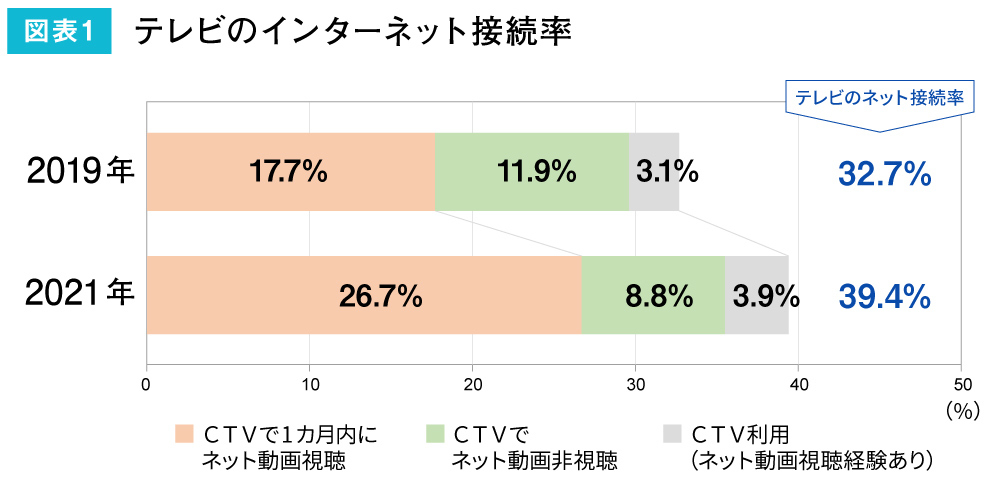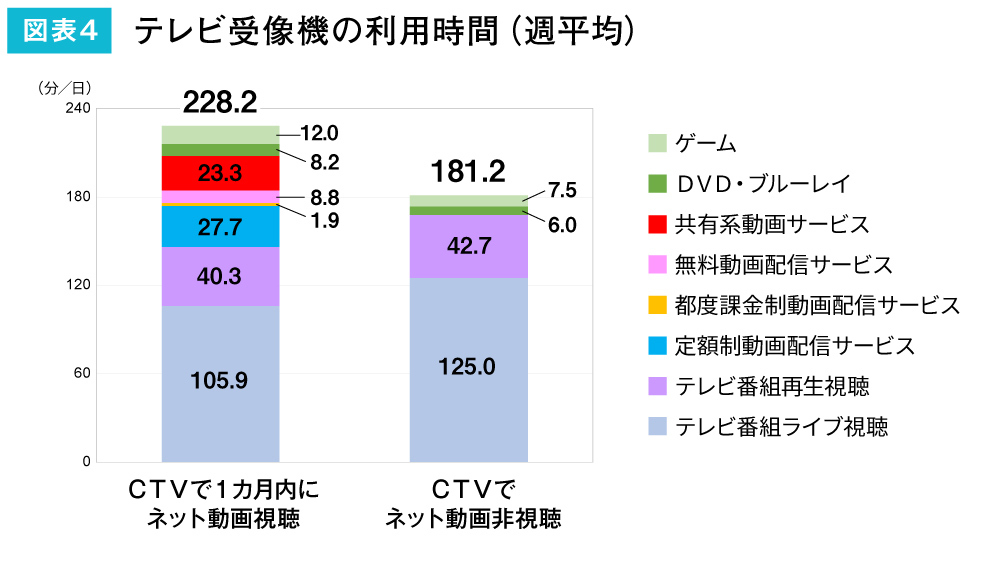This series introduces parts of the opening feature from Dentsu Inc. Media Innovation Lab's " Information Media White Paper 2022 " (published by Diamond Inc.). The previous article covered how daily activities and media consumption behaviors changed during the pandemic.
As time spent at home increases, viewing online videos on TV shows signs of expansion. Televisions connected to the internet either directly or via external devices are also called "Connected TVs" (CTV) and have gained significant attention in recent years. Therefore, this time, based on the "4th Survey on Internet Video Viewing via Television Sets" ( Survey Overview ) conducted by Dentsu Inc. Media Innovation Lab in September 2021, we introduce how internet videos are being watched on TV.
Home TVs connect to the internet, further expanding video viewing
The primary target of this survey was people who watched online videos on CTV within the past month. The number of CTV users, the basis for this survey, has increased with each survey. Figure 1 shows the results of the screening survey (targeting men and women aged 15-59 nationwide) used to select survey participants.

Source: Dentsu Inc. Media Innovation Lab "4th Survey on Online Video Viewing via Television Receivers"
Compared to the 3rd survey conducted in 2019, CTV users increased from 32.7% to 39.4%. This indicates growing internet connectivity for TVs, supported by factors like improved home Wi-Fi environments.
Furthermore, 26.7% of respondents reported watching online videos on CTV within the past month. This represents a significant increase from 17.7% in 2019. On the other hand, the percentage of people whose home TVs are connected to the internet but who do not watch online videos on them decreased from 11.9% to 8.8%. This suggests not only an improvement in the internet connectivity rate of TVs in households but also a broader adoption of online video viewing leveraging that connectivity.
Paid Video Streaming Service Use on TVs Increases During the Pandemic
When asked about online video services used on TV within the past month, YouTube had the highest usage rate among individual services. YouTube is already widely used on PCs and smartphones, and it is free. Additionally, some TV remotes have dedicated YouTube buttons. These factors suggest low barriers to using YouTube on TV.
When looking at service types, this survey shows for the first time that the usage rate of paid video streaming services (subscription-based or pay-per-view) exceeded that of shared video services, represented by YouTube (Figure 2). Representative paid video streaming services include Amazon Prime Video, Netflix, and Hulu.
Amid the pandemic, with increased time spent at home, paid video streaming services offering diverse content like original productions appear to have become a strong entertainment choice for people. Furthermore, it can be seen that TVs are increasingly being used as a viewing platform, alongside PCs and smartphones. The combination of these two factors likely explains why this survey found TV usage for paid video streaming services surpassed that of shared video services.

Source: Dentsu Inc. Media Innovation Lab "4th Survey on Internet Video Viewing via Television Sets"
What's Popular for CTV Viewing? Subscription Video Services: "Domestic Dramas"; Shared Video Services: "Music"!
So, what kind of online videos are being watched on TV? This survey confirmed trends largely consistent with past surveys. Figure 3 shows the video genres watched by users of subscription-based video streaming services and sharing-based video services on CTV. For subscription-based services, domestic dramas lead the way, followed by domestic and international dramas, movies, anime, and others.
On the other hand, viewing habits on sharing-based video services show greater diversity. Music tops the list, likely reflecting cases where music videos are played as background music. Additionally, popular online video genres like gaming and animal content are also watched on CTV.

Source: Dentsu Inc. Media Innovation Lab "4th Survey on Online Video Viewing via Television Sets"
Television Excels as a Platform for Online Video Viewing
The "4th Survey on Online Video Viewing via Television Sets" examined the amount of time people who watch online videos on CTV spend using television. Figure 4 shows the average daily television usage time (weekly average, estimated based on responses regarding frequency and duration of use) for those who watched online videos on CTV within the past month and those who did not watch online videos on CTV.

Source: Dentsu Inc. Media Innovation Lab "4th Survey on Online Video Viewing via Television Sets"
The group that "watched online videos on CTV within the past month" spent 228.2 minutes with television, 47 minutes longer than the group that "did not watch online videos on CTV," indicating a higher level of engagement with television.
Looking at usage breakdown, time spent watching live TV programs and recorded TV programs is 19.1 minutes (live viewing) and 2.4 minutes (recorded viewing) shorter, respectively, than for the non-viewing group. This indicates that the increase in total contact time is driven by time spent using online video services.
It is important to note that the difference between the two groups does not indicate a causal relationship where using online video services reduces TV program viewing time. However, the length of time spent using TV by those who watch online videos on CTV demonstrates that TV, already widely adopted as a device for watching TV programs, is also exceptionally well-suited as a device for watching online videos.
Internet-connected TVs dramatically expand the range of videos available for viewing. Beyond the qualitative and quantitative growth of video content, improvements in hardware convenience (including remotes), along with further enhancements to service UIs and recommendation features, are likely to drive even greater diversification in how TVs are used going forward.
This time, we introduced how people are selecting media services and devices that meet their needs and incorporating them into their lives as time spent at home increases during the pandemic. To address diverse needs, services like TVer and NHK Plus, which stream TV programs online, continue to evolve their features. Understanding the environment surrounding consumers and their behaviors will become increasingly important for providing services that people choose.
[Survey Overview]
Survey Name: 4th Survey on Internet Video Viewing via Television Sets
Period: September 2021
Survey Method: Internet survey
Survey Area: Nationwide
Survey Participants: 3,031 men and women aged 15 to 59
Used online video services on a TV within the past month (1,535 people)
Individuals with internet-connected TVs but who did not use online video services (1,496 people)
*Weighted back to match the appearance rate from the screening survey (37,037 men and women aged 15–59 nationwide) and the sex and age composition ratio from the 2021 Basic Resident Register









